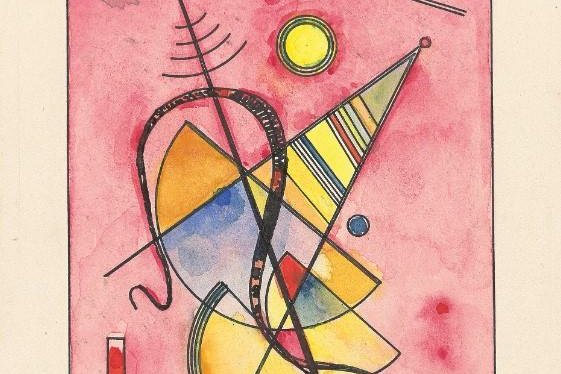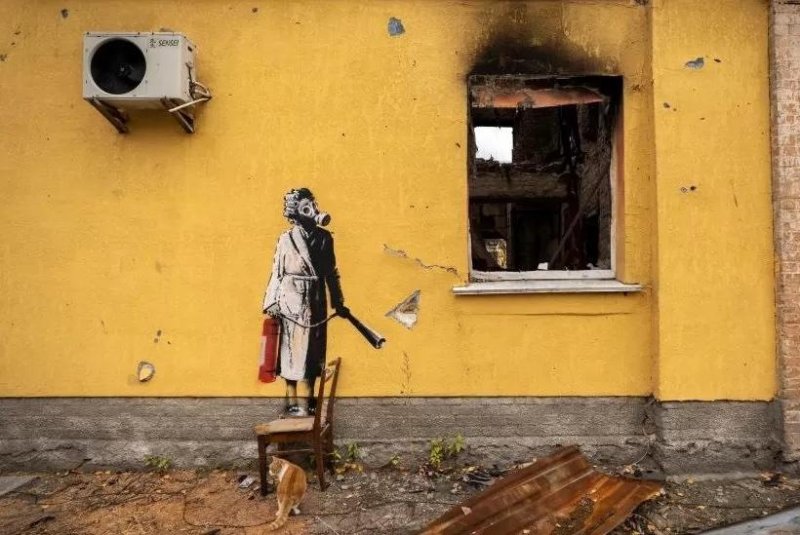By Adam Schrader

Poland’s Ministry of Culture and Natural Heritage has said it will take legal action and seek restitution after a Wassily Kandinsky painting believed to be stolen from the National Museum in Warsaw was sold at a German auction. Photo courtesy of Grisebach
Dec. 3 (UPI) -- Poland's Ministry of Culture and Natural Heritage has said it will take legal action and seek restitution after a Wassily Kandinsky painting believed to be stolen from the National Museum in Warsaw was sold at a German auction.
"In connection with the sale of Wassily Kandinsky's watercolor "Composition", stolen in 1984 from the collection of the National Museum in Warsaw, at the German auction house Grisebach, we will take all possible legal steps to recover the work," the Ministry of Culture said in a statement on Thursday.
"At the same time, we emphasize that we consider the transaction carried out knowingly by the Grisebach auction house to be highly unethical and contrary to the standards that should apply on the international art market."
Kandinsky, the Blue Rider and Bauhaus painter, was born in Moscow but raised in the Ukrainian city of Odesa and graduated from the Grekov Odesa Art School. He made the painting "Untitled (1928)" with watercolor and pen with black ink on cardboard.
The painting was sold by Grisebach at an auction on Thursday for $408,328, according to a listing by the auction house.
In a description for the provenance of the painting, which is the term used in the art world to describe the tracking of such artifacts as they change hands over time, the auction house said the work had been consigned for sale by the Hamburg-based German philanthropist Maren Otto, who bought it in 1988 from Galerie Thomas in Munich.
The painting was acquired by Warsaw's National Museum from a private collection in 1982 but was stolen from the museum in June 1984 when it was presented in an exhibition titled Concepts of Space in Contemporary Art, according to a 1985 report from the International Foundation for Art Research.
"To this day, the seal of the National Museum in Warsaw has been preserved on the back of the watercolor, which clearly indicates its origin. The auction house itself, indicating the history of watercolors, admits that it was in Polish public collections," Poland's Ministry of Culture said in a statement ahead of the auction.
"Despite the request to withdraw the work by W. Kandinsky, the auction house Grisebach intends to sell it."
A Grisebach spokesperson told The Art Newspaper on Saturday that the auction house does not doubt that the purchase of the watercolor in 1998 was made in good faith.
"Grisebach first became aware of a possible theft from a Polish museum shortly before the auction through a communication from the Polish Ministry of Culture," the spokesperson said.
"This notification was immediately taken as an opportunity to enter into a further legal investigation. This led to the clear conclusion that there were no legal objections to the auction of the watercolor."
The spokesperson told The Art Newspaper that the auction house has contacted Otto and the purchaser and will "endeavor to bring about a supplementary judicial legal review by a court in order to obtain a binding clarification."
Ukrainian police foil attempt to steal Banksy mural

Police in Ukraine on Friday arrested eight people for trying to steal a mural by graffiti artist Banksy. Photo provided by Kiev Regional Government/Telegram
Dec. 3 (UPI) -- Eight people who attempted to steal a mural by graffiti artist Banksy off the wall of a war-torn building in the Ukrainian city of Hostomel have been arrested, officials said Saturday.
Police said the group cut off a section of board and plaster bearing the artwork of a woman in a gas mask.
Eight people were arrested at the scene in the town near Kyiv. The graffiti is undamaged and police are protecting it, the governor of Kyiv region, Oleksiy Kuleba, said on Telegram.
"These images are, after all, symbols of our struggle against the enemy," he said. "These are stories about the support and solidarity of the entire civilized world with Ukraine.
"We'll do everything to preserve these works of street art as a symbol of our victory."
Banksy, whose identity is unknown, is one of the most well-known street artists in the world and he has confirmed that he is behind pieces that have appeared in areas of Ukraine that had been attacked by Russian forces.
Banksy's pieces regularly fetch millions at auction, creating an incentive for thieves to take his public work, according to Forbes.
Banksy is one of the world's most famous artists, rising to prominence with stenciled designs in Britain in the early 1990's.

Police in Ukraine on Friday arrested eight people for trying to steal a mural by graffiti artist Banksy. Photo provided by Kiev Regional Government/Telegram
Dec. 3 (UPI) -- Eight people who attempted to steal a mural by graffiti artist Banksy off the wall of a war-torn building in the Ukrainian city of Hostomel have been arrested, officials said Saturday.
Police said the group cut off a section of board and plaster bearing the artwork of a woman in a gas mask.
Eight people were arrested at the scene in the town near Kyiv. The graffiti is undamaged and police are protecting it, the governor of Kyiv region, Oleksiy Kuleba, said on Telegram.
"These images are, after all, symbols of our struggle against the enemy," he said. "These are stories about the support and solidarity of the entire civilized world with Ukraine.
"We'll do everything to preserve these works of street art as a symbol of our victory."
Banksy, whose identity is unknown, is one of the most well-known street artists in the world and he has confirmed that he is behind pieces that have appeared in areas of Ukraine that had been attacked by Russian forces.
Banksy's pieces regularly fetch millions at auction, creating an incentive for thieves to take his public work, according to Forbes.
Banksy is one of the world's most famous artists, rising to prominence with stenciled designs in Britain in the early 1990's.
Looted art, artifacts seized by Manhattan DA were recovered from home of The Met trustee

Shelby White, a trustee of the Metropolitan Museum of Art in New York City, has been revealed as the former owner of looted artifacts recently returned to Turkey, including a life-size bronze statue of the Roman Emperor Lucius Verus.
Photo courtesy of U.S. Consulate General Istanbul/Facebook
Dec. 2 (UPI) -- Nearly two dozen looted objects that were seized by the office of Manhattan District Attorney Alvin Bragg in recent months were recovered from the home of a trustee of the Metropolitan Museum of Art in New York City, reports said.
Warrants provided by the Manhattan DA to The Art Newspaper and Hyperallergic on Friday showed that 23 of the antiquities were seized by authorities from the home of Shelby White during a lengthy investigation into the provenance of the art and historical objects.
Investigators obtained the search warrants in June 2021 and in April 2022 that Homeland Security agents had "reasonable cause" to believe they were stolen, according to The Art Newspaper.
Some of those pieces have already been repatriated to Turkey and Italy, including a third-century statue worth $15 million, Hyperallergic reported.
Dec. 2 (UPI) -- Nearly two dozen looted objects that were seized by the office of Manhattan District Attorney Alvin Bragg in recent months were recovered from the home of a trustee of the Metropolitan Museum of Art in New York City, reports said.
Warrants provided by the Manhattan DA to The Art Newspaper and Hyperallergic on Friday showed that 23 of the antiquities were seized by authorities from the home of Shelby White during a lengthy investigation into the provenance of the art and historical objects.
Investigators obtained the search warrants in June 2021 and in April 2022 that Homeland Security agents had "reasonable cause" to believe they were stolen, according to The Art Newspaper.
Some of those pieces have already been repatriated to Turkey and Italy, including a third-century statue worth $15 million, Hyperallergic reported.
The collection of White and her late husband Leon Levy was previously scrutinized in a study published in the American Journal of Archaeology in 2000 after more than 200 objects were displayed in an exhibition at The Met.
That study found that 93% of the works in that exhibit had no known provenance, which is the term used in the art world to describe the tracking of such artifacts as they change hands over time.
White previously repatriated parts of her collection in 2008 when she returned 10 objects to Italy and another two to Greece after public backlash.
RELATED Wellcome Collection ending display of Medicine Man, calling it racist, sexist, ableist
Officials in the United States, as well as researchers in the art world, have been increasing their efforts to repatriate stolen artifacts in recent years.
Last month, a highly anticipated database of the Benin Bronzes, a massive trove of art and cultural artifacts looted from the Kingdom of Benin by the British empire in 1897, was launched and could help shape the future of art restitution.
That project, Digital Benin, began in 2020 and has culminated with a catalog of 5,246 historic Benin objects currently held in 131 institutions across 20 countries.
RELATED France's Culture Ministry issues report on museums acquisition policies to curb art racketeering
The news came as it was revealed that Leon Black, a trustee and former board chair of the Museum of Modern Art in New York City, has been accused of raping a woman at Jeffrey Epstein's mansion in New York City.
The lawsuit was filed by the woman, Cheri Pierson, in the New York State Supreme Court in Manhattan on Monday and she has demanded a jury trial.
No comments:
Post a Comment